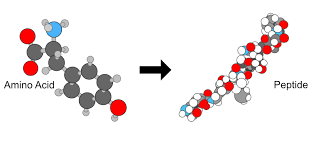Peptides consist of two or more amino acids linked together linearly. Peptide bonds are the chemical bonds that connect amino acids. Peptides become proteins as they adopt more complicated structures (usually 50 amino acids or more in length). They serve several purposes inside the human body and are the cornerstone of several pharmaceuticals.
Physiological Roles
Peptides serve a wide variety of functions in the body. Here are a few examples of peptides and the tasks they perform:
The hypothalamus, a tiny structure near the brain’s base, is responsible for secreting the peptide hormone vasopressin (antidiuretic hormone). There are a few uses for Vasopressin.
As a result of its actions, the kidneys can absorb water from the extracellular fluid, therefore controlling the quantity of water in the surrounding fluid cells. Steroids UK is another option. When present in large enough doses, Vasopressin also acts as a vasoconstrictor, narrowing blood vessels and raising blood pressure. Consuming alcohol reduces the hormone Vasopressin, leading to more frequent urination.
The pituitary gland in the brain synthesizes the peptide hormone Oxytocin, which consists of nine amino acids. It’s what makes the contractions stronger while someone is giving birth. In addition, Oxytocin is essential in the let-down reflex, the process by which breastfed infants expel their milk. Because it is produced during social bonding and cuddling, Oxytocin has been dubbed the “cuddle hormone” or the “love hormone.”
Defensins: These peptides are mostly immune system active and are assumed to be antibacterial, facilitating wound healing.
The renin-angiotensin system includes the peptide hormones known as angiotensins. They boost salt retention by the kidneys and assist with blood pressure regulation. Adrenal corticosteroid secretion is also increased.
Uses in Medicine
Peptides may act as antioxidants, kill bacteria, and prevent blood from clotting. More than 60 peptide medications have received regulatory approval in the United States and other markets worldwide as of 2017. Both naturally occurring and synthesized peptides are employed in medical treatments.
- Vasopressin is one example of a peptide used to treat diabetic insipidus. Researchers may also treat antidiuretic hormone deficit with them.
- You’ll find the dipeptide and antioxidant carnosine in the heart, kidneys, intestines, skin, brain, and muscles. Alzheimer’s disease, brain ischemia, autism, Down syndrome, Parkinson’s disease, schistosomiasis, and epilepsy are among the illnesses that may benefit from its usage, according to research. It may also help protect the eyes from developing cataracts.
- Broad-spectrum antibacterial actions are a hallmark of peptides such as defensins. Current research is looking at synthetic defensins as a potential treatment for HIV-1.
- In the body, iron absorption is regulated by the peptide hormone hepcidin. Its blood concentration is a useful diagnostic marker for anemia.
- The peptide chromofungin has shown promise in animal models of inflammatory bowel disease (IBD).
- Hepatitis C, pneumonia, HIV, and certain bacterial infections are only a few of the illnesses treated using antimicrobial peptides. Peptides may be injected intravenously (IV), applied topically, or taken orally.
Cancer
Numerous peptides are under investigation as potential cancer therapies. For instance, atrial natriuretic peptide (ANP) has shown promising results in animal models of colorectal cancer.
Some cancer therapies based on peptides are already on the market and helping patients. Medications that act as agonists of the Gonadotropin-releasing hormone (GnRH) receptor, such as luteinizing hormone-releasing hormone (LH-RH) agonists, are used to treat several types of cancer, including ovarian and prostate cancer.
Vaccines that Work Via Peptides
Vaccines depend critically on peptides. Vaccines based on peptides can imitate the immune system’s response to pathogens (disease-causing microorganisms) by using a synthetic peptide to mimic the natural protein.
Vaccinating a patient with peptides from their tumor antigens elicits an anti-tumor T cell response, which is then utilized to treat the malignancy.
Although vaccines based on peptides show great promise, they are not without their drawbacks. Vaccines based on inactive or weakened microorganisms and peptide-based vaccines have very different mechanisms of action. Still, the medical and scientific sectors have a common goal of developing an effective Alzheimer’s vaccine in the future. Vaccines based on a specific pathogen often elicit a more robust immune response, providing better protection.
Buy peptides only if you are a researcher interested in further studying this compound. For the best supplier, click here.
Write and Win: Participate in Creative writing Contest & International Essay Contest and win fabulous prizes.
















